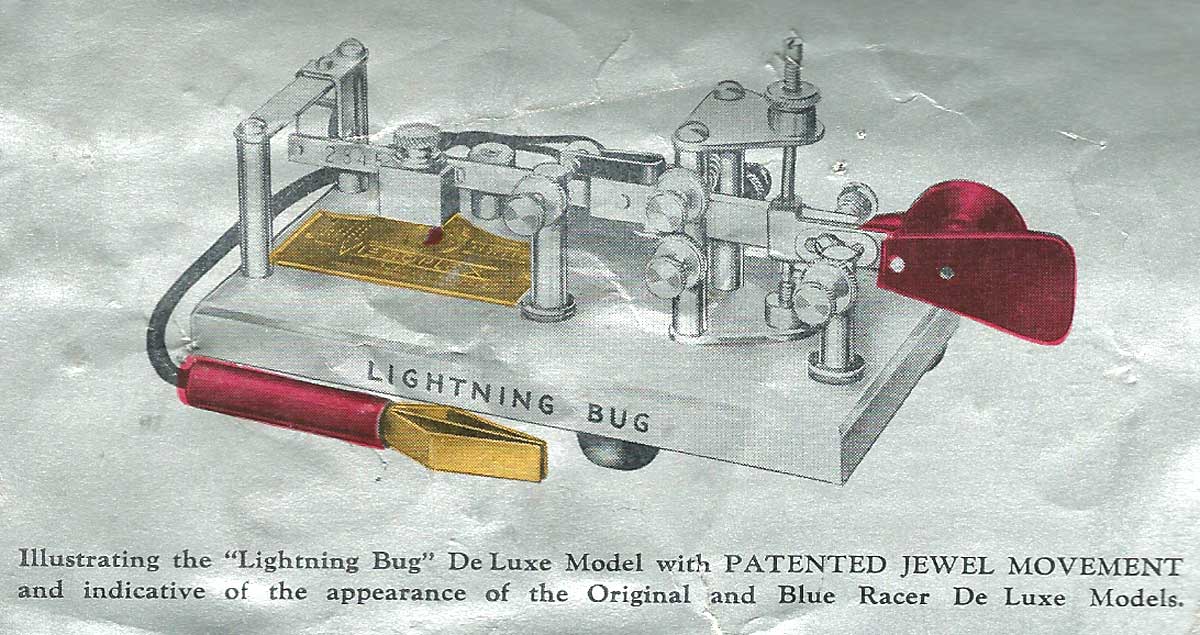
Sunday, June 19, 2016, 10 p.m. — I didn’t win the Powerball last night (or the Kentucky Lottery for that matter), so it looks like I’m going to have to sit out this week’s round of eBay code key bidding. Of course, browsing eBay is always fun, particularly when you can see the rarest of the rare keys up for auction. Click the thumbnail images to enlarge them (be aware you may need to click them twice).
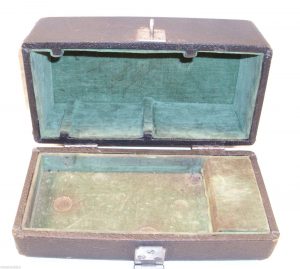 UNUSUAL CASE. This 1940 Vibroplex Lightning Bug DeLuxe is an early DeLuxe that features the relatively new-at-the-time change to chrome plating but without the jeweled pivots that were soon to be part of every DeLuxe Vibroplex key. The $299.99 Buy It Now price is fairly steep; however, my interest this listing is primarily the case: Unlike most you see that have one end hinged to allow the bug to be inserted, this case is split above the bottom of the case, and it opens up like a jewelry box. If you check the interior, the photos show the same sort of felt lining you find in Vibroplex cases; the construction appears the same, and even the “simulated Moroccan” leather is the same. The case has a large hasp on it to allow the owner to lock it securely.
UNUSUAL CASE. This 1940 Vibroplex Lightning Bug DeLuxe is an early DeLuxe that features the relatively new-at-the-time change to chrome plating but without the jeweled pivots that were soon to be part of every DeLuxe Vibroplex key. The $299.99 Buy It Now price is fairly steep; however, my interest this listing is primarily the case: Unlike most you see that have one end hinged to allow the bug to be inserted, this case is split above the bottom of the case, and it opens up like a jewelry box. If you check the interior, the photos show the same sort of felt lining you find in Vibroplex cases; the construction appears the same, and even the “simulated Moroccan” leather is the same. The case has a large hasp on it to allow the owner to lock it securely.
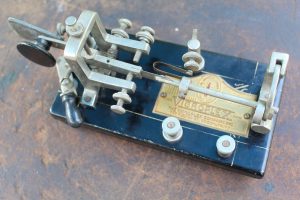 SWEET JUNIOR. This 1936 Vibroplex Junior is a really primo key. The plating and the base are in really great condition for an 80-year-old key. The Buy It Now price of $125 makes it an attractive buy; not for me this week, however (unless I promise to shed myself of a couple of my existing keys).
SWEET JUNIOR. This 1936 Vibroplex Junior is a really primo key. The plating and the base are in really great condition for an 80-year-old key. The Buy It Now price of $125 makes it an attractive buy; not for me this week, however (unless I promise to shed myself of a couple of my existing keys).
FIRST-YEAR BLUE RACER. Is the $425 Buy It Now price for a first-year 1914 Vibroplex #4 Blue Racer in good used condition too steep? The 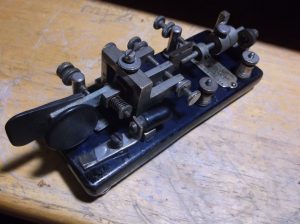 plating doesn’t look as worn as you might expect, and the cobalt blue base is in good condition (considering it is 102 years old). The seller stripped a coat of paint to find the original blue finish and the remains of a J.E. Albright sticker (nice work, guy!). We can debate prices until the cows come home, but at this point, this key is out of reach. It would be a fine specimen to add to any collector’s key collection. I’m going to list my Yaesu FT-817, wonder if the seller wants to trade? I can only wish (which — thankfully — is very inexpensive).
plating doesn’t look as worn as you might expect, and the cobalt blue base is in good condition (considering it is 102 years old). The seller stripped a coat of paint to find the original blue finish and the remains of a J.E. Albright sticker (nice work, guy!). We can debate prices until the cows come home, but at this point, this key is out of reach. It would be a fine specimen to add to any collector’s key collection. I’m going to list my Yaesu FT-817, wonder if the seller wants to trade? I can only wish (which — thankfully — is very inexpensive).
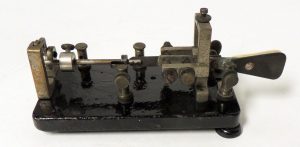 1907 PRE-NORCROSS? This is a very good example of a 1907 Vibroplex bug built (presumably) prior to the company’s move to Norcross, Ga. Note the offset horizontal arms on the main pivot frame; each arm is offset to the user’s left — as are the main frames of Original-style Norcross bugs. I’ve never read an explanation for the offset, but it only appears on the bugs built about 1907-1909.
1907 PRE-NORCROSS? This is a very good example of a 1907 Vibroplex bug built (presumably) prior to the company’s move to Norcross, Ga. Note the offset horizontal arms on the main pivot frame; each arm is offset to the user’s left — as are the main frames of Original-style Norcross bugs. I’ve never read an explanation for the offset, but it only appears on the bugs built about 1907-1909.
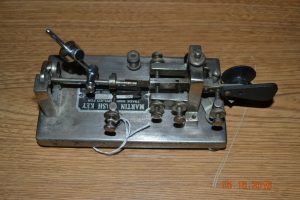 NICE 1930s MARTIN FLASH. This Martin Flash is a very nice example of the company’s “clone” of the Vibroplex Original. This example features a nickel-plated base, which isn’t commonly found. This key appears to have been made prior to the sale of Martin Research and Manufacturing of New York to the J.H. Bunnell Co.
NICE 1930s MARTIN FLASH. This Martin Flash is a very nice example of the company’s “clone” of the Vibroplex Original. This example features a nickel-plated base, which isn’t commonly found. This key appears to have been made prior to the sale of Martin Research and Manufacturing of New York to the J.H. Bunnell Co.
1917 DUAL LEVER. This nice example of a Vibroplex Dual Lever key sold earlier today for $560. Despite having some unwanted paint on parts of 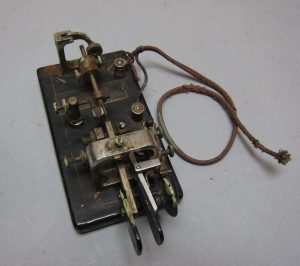 the key, it was a complete and operational rare key. A good find, but out of my financial league at the moment. I already have two dual lever keys, and while I’m never really against buying the same model in multiples (as in my seven 100th Anniversary Originals, hi hi!), at this price it would have to have something really, really special about it (or my check from the lottery arrived).
the key, it was a complete and operational rare key. A good find, but out of my financial league at the moment. I already have two dual lever keys, and while I’m never really against buying the same model in multiples (as in my seven 100th Anniversary Originals, hi hi!), at this price it would have to have something really, really special about it (or my check from the lottery arrived).
REMEMBER MY DAMAGED J-36? On the night of April 3, 2016, I started a chain reaction by hitting a box with my foot that ended up sending a nice Lionel J-36 business-end first straight to the floor. Did it break the thumb piece or bend the keying lever? Nope! The impact bent the top triangular pivot mount. ARGH!
A few weeks ago, I won an auction for what amounted to a nearly complete but disassembled 1944 Vibroplex Lightning Bug. My plan was to use the top plate from the Lightning Bug to repair the J-36 (despite different platings on their respective pieces). Well, that won’t be necessary.
I basically took some pliers and carefully straightened the top plate — without popping the threaded part out of its mounting hole. There’s still a bit of kink in the top plate, but it looks pretty good and functions as well as it did when new. I did clean the key up before reassembling it, and then hooked it up. The thing plays very well — I just need to come up with the J-36 labels. I had an envelope of some I had made, I have two keys that need them to look complete and restored now.
My next project will be to reassemble the 1944 Lightning Bug and see what parts it needs to be complete.
-30-
